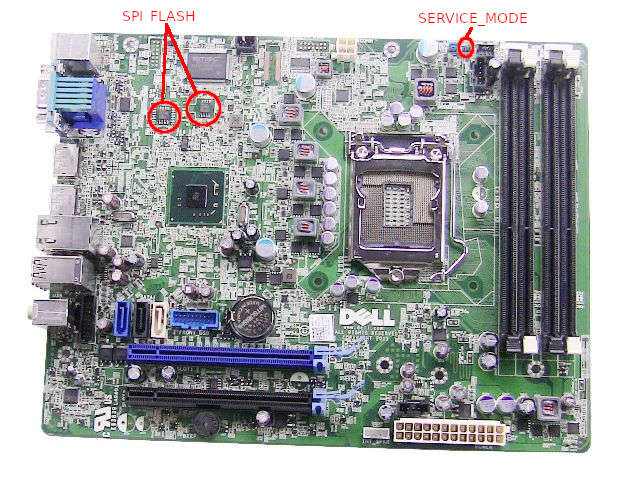Dell OptiPlex 9010
This page describes how to run coreboot on Dell OptiPlex 9010 SFF.

Technology
CPU |
Intel Core 2nd Gen (Sandybridge) or 3rd Gen (Ivybridge) |
DRAM |
Up to 4 DIMM slots, up to 32GB 1600MHz non-ECC DDR3 SDRAM |
Chipset |
Intel Q77 Express |
Super I/O |
SMSC SCH5545 (or SCH5544) with Environmental Controller |
TPM |
ST Microelectronics ST33ZP24 |
Boot |
From USB, SATA, NVMe (using PCIe x4 expansion card) |
Power |
200W-275W PSU |
More specifications on Dell OptiPlex 9010 specifications.
Required proprietary blobs
Binary file |
Apply |
Required / Optional |
|---|---|---|
smsc_sch5545.bin |
SMSC SCH5545 EC |
Optional |
microcode |
CPU microcode |
Required |
Microcode updates are automatically included into the coreboot image by build
system from the 3rdparty/intel-microcode submodule.
SMSC SC5545 EC firmware is optional, however lack of the binary will result in
EC malfunction after power failure and fans running at full speed. The blob can
be extracted from original firmware. It should be located under a file with
GUID D386BEB8-4B54-4E69-94F5-06091F67E0D3, raw section. The file begins with a
signature SMSCUBIM. The easiest way to do this is to use UEFITool and
Extract body option on the raw section of the file.
Flashing coreboot
Type |
Value |
|---|---|
Socketed flash |
no |
Model |
MX25L6406E/MX25L3206E |
Size |
8 + 4 MiB |
Package |
SOIC-16 + SOIC-8 |
Write protection |
chipset PRR |
Dual BIOS feature |
no |
Internal flashing |
yes |
Internal programming
The SPI flash can be accessed using flashrom.
flashrom -p internal -w coreboot.rom --ifd -i bios
Internal programming will not work when migrating from original UEFI firmware. One will have to short the SERVICE_MODE jumper to enable HMRFPO and then boot the machine to flash it.
External programming
The external access to flash chip is available through standard SOP-8 clip and/or SOP-16 clip on the right side of the CPU fan (marked on the board image). The voltage of SPI flash is 3.3V.
There are no restrictions as to the programmer device. It is only recommended to flash firmware without supplying power. There are no diodes connected to the flash chips. External programming can be performed, for example using OrangePi and Armbian. You can use linux_spi driver which provides communication with SPI devices. Example command to program SPI flash with OrangePi using linux_spi:
flashrom -w coreboot.rom -p linux_spi:dev=/dev/spidev1.0,spispeed=16000
Schematics
There are no schematics for SFF, but if one looks for MT/DT schematics, they can be found publicly. Most of the schematics should match the SFF (although MT/DT has additional PCIe and PCI slot).
Known issues
There seems to be a problem with DRAM clearing on reboot. The SSKPD register still contains 0xCAFE which leads to reset loop.
Untested
Not all mainboard’s peripherals and functions were tested because of lack of the cables or not being populated on the board case.
Internal USB 2.0 header
Wake from S3 using serial port
Wake-on-Lan from ACPI S4/S5
Working
USB 3.0 and 2.0 rear and front ports (SeaBIOS and Linux 4.19)
Gigabit Ethernet
VGA and 2x DP port using libgfxinit
flashrom
PCIe x1 WiFi in PCIe x4 slot
NVMe PCIe x4 using PCIe x4 expansion card
PCIe x16 PEG port using Dell Radeon HD 7570
SATA ports (SATA disks and DVD)
Super I/O serial port 0 (RS232 DB9 connector on the rear side)
SMBus (reading SPD from DIMMs)
CPU initialization using Intel i7-3770
Sandy Bridge/Ivy Bridge native RAM initialization
SeaBIOS payload (version rel-1.13.0)
PS/2 keyboard and mouse (including wake support)
LPC debug header (requires soldering of the pin header and shorting RF24 for LPC clock)
USB debug dongle (the most bottom USB 2.0 port under RJ45 on the read side)
SMSC SCH5545 Super I/O initialization
SMSC SCH5545 EC initialization and firmware update
SMSC SCH5545 EC automatic fan control
TPM 1.2
Booting Debian 10, Ubuntu 18.04, QubesOS R4.01
Boot with cleaned ME
Intruder detection
Wake-on-Lan from ACPI S3